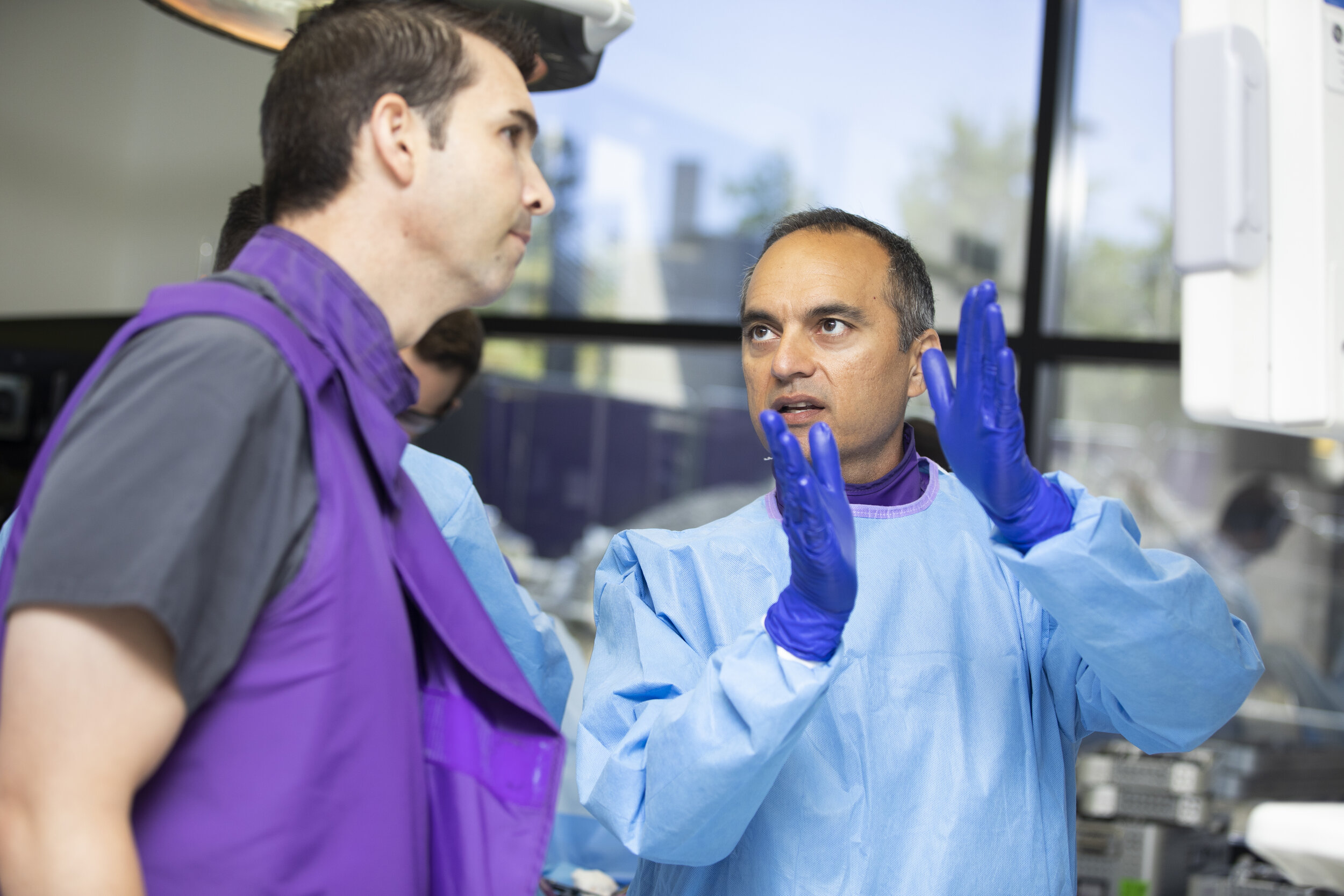
How Do I Know If I Need Surgery?
Many people experiencing neck and back pain do not need surgery. For these patients, non-surgical treatments, medication and physical therapy may be the best options. However, for those patients who experience long term pain that has not improved with other treatments, spine surgery may be recommended to fix the problem. But spine surgery cannot fix all problems. Surgery will only be recommended if there is a high probability it will help. Whenever possible, a minimally invasive procedure is the preferred surgical route. No matter the case, it is always best to investigate all available options prior to moving forward with surgery.
The best treatment for each patient must be based on an accurate diagnosis. I begin by working with my team to take your medical history and perform a physical examination. After testing to confirm a diagnosis and locate the source of your pain, we will determine which treatment would be most beneficial to you. A course of action will be designed and decided upon by both of us.
Although it is appealing to have the latest procedure, the newest medication or the smallest micro-surgery, a treatment must be appropriate for each patient’s condition. Treatment must also be based on scientific evidence, not on “good marketing.” We pride ourselves on making correct and complete diagnoses, then offering patients the most effective treatment.
I, and my team, are committed to optimizing the health of your spine. I explore every treatment option available for your condition. Surgical procedures are only considered when all other options have been eliminated. We want to work with you to identify the best path back to health. It is our mission to provide technically advanced, high quality surgical care to each patient in a compassionate, effective, educational, least invasive and personalized manner. Spine surgery must be taken seriously. It is imperative to select the right procedure for the right patient at the right time.
Appointment Preparation
We want to ensure you get the most out of your appointment. Please bring the items listed below with you to, or share with my team in advance of, your appointment. With the right information we will have everything necessary to identify, understand and treat your condition.
Please bring the following items with you to your initial appointment:
Driver’s License or other form of photo identification
Insurance cards
Completed Patient Form (Click here to view and print)
All radiology studies pertaining to your case along with the report, CD or actual films including:
X-Rays
MRI scans
CT scans
Operative and radiology reports
Prior medical reports
Injection history
EMG and Nerve Conduction results
Consultations from other and/or referring physicians
Information of ALL physicians involved in your care (including your PCP)
List of questions and concerns
What to expect/FAQs
Back pain is the number one reason people go to the doctor. In fact, about 80 percent of Americans experience back pain, especially lower back pain, in their lifetime. And anyone can develop back pain, irrespective of age, race or gender.
Most patients are offered conservative treatments such as physical therapy or injections before the subject of surgery is even broached. Only if these fail or aren’t applicable to your condition will more aggressive forms of treatment be considered.
For many medical conditions, minimally invasive back surgery is the best recourse to eliminate spine pain and injury permanently. If it’s determined that a minimally invasive spine surgery is right for you, you’ll find that recuperation and recovery is far different from what has previously been possible.
And not only is Dr. Khanna a specially trained and experienced expert in ensuring your surgery is successful, he trains other orthopedic spine surgeons worldwide on how to get you back to your normal routine as quickly as possible. Here’s what you need to know about what to expect before and after a minimally invasive spine surgery:
Before Surgery: Checklist
To help you to recover quickly, you can do a few things on your own. These will aid your body to be more resilient, setting you up to heal.
Examine your diet. Losing a few pounds before the surgery puts less stress on your joints. Quit sugary drinks and cut back on oily foods. Processed foods put unnecessary chemical interruptions into your system. At times this can be a hinderance to healing for the body.
Quit smoking and give up alcohol prior to your procedure. Again, excess chemicals in the body can hold back healing and affect medication effectiveness during and after surgery.
Take up stretching and other forms of mild exercises, like yoga and Pilates; but be sure to with Dr. Khanna, as not to further aggravate your symptoms. Getting your body used to movement and gaining strength can help to shorten recovery time.
Although your spine doctor performs an extensive medical history with you before the surgery, make sure you mention again any medical conditions or diseases you have -- like diabetes, blood pressure, allergies to medications and/or sensitivity to anesthesia or hemophilia. These can all cause potential complications during a surgery.
After Surgery: Going Home
The first question patients ask is when they can go home. Often the answer to this is, the same day as surgery. However, factors such as your specific procedure and overall health condition will play a role in your immediate post-op recovery time.
The ability to send patients home quickly is a direct result of the MIS procedure. The incisions are very small and, as a result, there is very little blood loss or trauma to internal tissue, muscle or bone.
After Surgery: Healing Time
The surgical technique of minimally invasive spine surgery causes so little trauma, and involves such small incisions, patients generally heal much faster. Naturally, the more the condition, the more complicated the procedure. This may require longer downtime and more restrictions. But most procedures allow patients to be considered fully healed in under a month.
Additional post-op instructions usually include:
Take care of your incision— Even with such a small incision, there is always a risk of infection if not properly cared for. Dr. Khanna will make you aware of the potential symptoms, such as pain, swelling, or fever. These are all reasons to contact him immediately.
Take medications as prescribed— Misuse of prescription meds can be dangerous and may lead to dependency. However, not taking meds while you’re recovering can delay the healing process.
Exercise as advised— Movement promotes healing. But too much, too soon, could have the opposite effect. Talk to Dr. Khanna about any exercise you would like to pursue and when you can resume these activities.
Be patient— It can be challenging to work back to a normal routine. Dr. Khanna’s orders are meant to help ensure a long-term, pain-free recovery and life for you. Slow is good.
After Surgery: Pain
Every patient has a different pain tolerance. However, even patients who are highly sensitive to pain report an improvement in their pain experience after minimally invasive procedures. The minimal trauma to muscles and tissue mean less pain, less need for pain medication, and less stress.
After the procedure, you will feel sore as you move around for the first few days. A pain killer or over-the-counter pain reliever may be prescribed for the short-term discomfort. Most people don’t need heavy doses of medication. The main precaution you will need to take at home is to keep your surgical wound clean.
And, to help patients recover more quickly, regain mobility and prevent future injuries, it is often recommended that a specific course of graduated exercises be administered and managed through a physical therapist.
After Surgery: Return to Activity
Often my patients are concerned about when they can return to normal activities – work, exercising, caring for children, and more. Most people can return to their job and normal activities within a matter of weeks, rather than months.
In fact, following minimally invasive spine surgery, most patients return to work within two weeks or less. Just make sure you don’t lift heavy things or move too quickly. Dr. Khanna and his physical therapy team will provide you with a custom list of best practices to ensure a speedy and uneventful recovery.
The number one thing to remember, slow down your movements during recovery to prevent problems. Stretching exercises, as prescribed, allow you to improve mobility. You may also need additional therapy to build up your spine muscles again, possibly tighten your hamstrings, and re-strengthen your core as well as to re-build stamina.
After Surgery: Prevention
Once you have returned to normal activities, you need to make sure your neck and back pain problems do not return. Some tips for staying pain-free include:
Continue your stretching exercises.
Lift heavy things correctly.
Correct your posture.
If you’re overweight, every extra pound puts more pressure on your spine. Consider revising your eating habits to lessen this spine stress.
Swimming aerobics can also be helpful. The water cushions your spine while you move.
MRI Consultation
Might you be a candidate for an MIS procedure? Dr. Khanna will review your existing MRI CD and report. Based on the review, he will determine if you are a candidate for a minimally invasive procedure and provide the best course of action to move forward with treatment.
An MRI is a non-invasive, radiation-free scanning technology that produces clear
and detailed images. MRI’s can be used to precisely locate injuries or abnormalities as well as previous trauma. The technology of an MRI is an invaluable tool to detect a wide range of joint and musculoskeletal disorders.
Our unit is extra wide, quiet and comfortable, while still able to produce the highest quality images. This imaging accommodates both children and adults who experience claustrophobia, anxiety or limited mobility. Our MRI:
Facilitates superior images for orthopedic diagnosis
Images and studies are read by Board Certified Radiologist
Results are available to the patient and physician within 48 hours
Physical Therapy
Physical therapy is intended to increase and restore functional ability and quality of life to those with physical impairments or disabilities affecting the brain, spinal cord, nerves, bones, joints, ligaments, muscles and tendons. Unlike other medical specialties that focus on a medical “cure”, the goal of PT is to maximize the independence of a patient in activities of daily living and improve their quality of life.
Physical therapists create comprehensive, patient-centered treatment plans and are integral members of my care team. Utilizing cutting-edge, as well as time-tested treatments, they maximize functional abilities for patients, drawing on their broad range of knowledge including musculoskeletal, neurological, rheumatological and cardiovascular systems.
Our outpatient physical therapists manage the treatment of nonsurgical conditions including:
Orthopedic injuries
Spine-related pain and dysfunction
Occupational injuries and overuse syndromes
Neurogenic bowel/bladder
Spasticity management
Chronic pain
Post-op recovery and exercise
Before surgery, Dr. Khanna works with his physical therapy team to identify the best non-invasive treatments for your spine condition. However, if surgery is necessary, after, Dr. Khanna and the PT team will provide you with a custom list of best practices to ensure a speedy and uneventful recovery.



